
|
|
From the Editor - April 1st , 2020
Like many of you, I'm currently in self-isolation mode, which is a bit of a drag to say the least. One thing that has really been affected by the pandemic is the pleasurable business of getting together to fly our models. Like many others, my own club has now cancelled its planned Spring/Summer contest season - even the Executive, of which I'm a member, no longer meets. We can still fly at our field, but only under conditions of strict self-isolation from others - no fun there, and not possible if you require a holder/launcher. I see that this restriction has extended into the major national and international contest spheres. To take just one example, I hear from Ingemar Larsson that this year's Karlskoga World Cup meeting in Sweden has been cancelled. Other such contests are bound to follow. Overall, this is shaping up to be a year to forget.........but to forget it, we first have to get through it!  On the website front, there's both good and bad news. On the good side, user access appears to have been maintained, and I have regained control of the material which appears on this site. Hence the appearance of this Editorial and the accompanying feature articles. The bad news is that I still haven't regained full access to the administrative pages associated with the site, including the user statistics. I realize that my ongoing website problems pale into insignificance compared with the broader issues now facing all of us, but the fact remains that I now have absolutely no idea if anyone is still reading this stuff given the many competing distractions now presenting themselves. The question now facing me is very stark and simple - am I accomplishing anything worthwhile by continuing to publish these monthy features? Or am I preaching to a non-existent congregation, with everyone's attention having been quite understandably transferred to other more pressing matters? I'd like to think that my monthly editions might contribute to the well-being of my readers by giving them something to look forward to and to spend some enjoyable escapist time perusing, but am I right?!? Perhaps these articles are an unwanted distraction at present. I'd very much appreciate honest feedback on this topic. Now a note which has unfortunately had to continue to be a regular feature of these Editorials. This one is directed specifically towards new readers - old hands should skip down to the following sections.
Despite my repeated admonitions not to do so, people are continuing to try to register on this website. The numbers have fallen, but it's still happening. As I've previously stated time and time again, this has absolutely no effect - it's simply an artefact left over from the generic platform's primary intended use as an on-line sales site. Since this is not a sales site, the registration feature is redundant and I make no use of it whatsoever.
Due no doubt to the COVID-19 pandemic, the contacts from my valued readers and correspondents have fallen off somewhat over the past month. This is another factor which has me questioning the value of continuing at the present time - perhaps no-one's paying any attention these days. I have continued my testing program at home (hoping that the neighbours don't come out of self-isolation to lynch me!) and have completed a number of articles which are all ready to go, but is this the time to be putting them up?!? I don't know .............. Even so, I did hear from a fair number of you during March, including (in no particular order) Alan Brown, Maris Dislers, Dave Jones, Ingemar Larsson, Lars Gustafsson, Steve Webb, Luis Petersen, Peter Valicek, Alan Strutt, Mike Conner, Bill Wells, Miles Patience, Ken Croft, Ian Russell, Paul Venne, Tim Dannels, Johnny Shannon, Chris Ottewell, Yuancao, Don Sohn, Tom Coletta, Howard Fields, David Hill, Max Tenet, Dave Causer, Sergio Montes, Richard Barlow and Andrew Coholic. The blog site has also continued to justify its existence by generating a small but steady flow of relevant traffic - thanks for that. 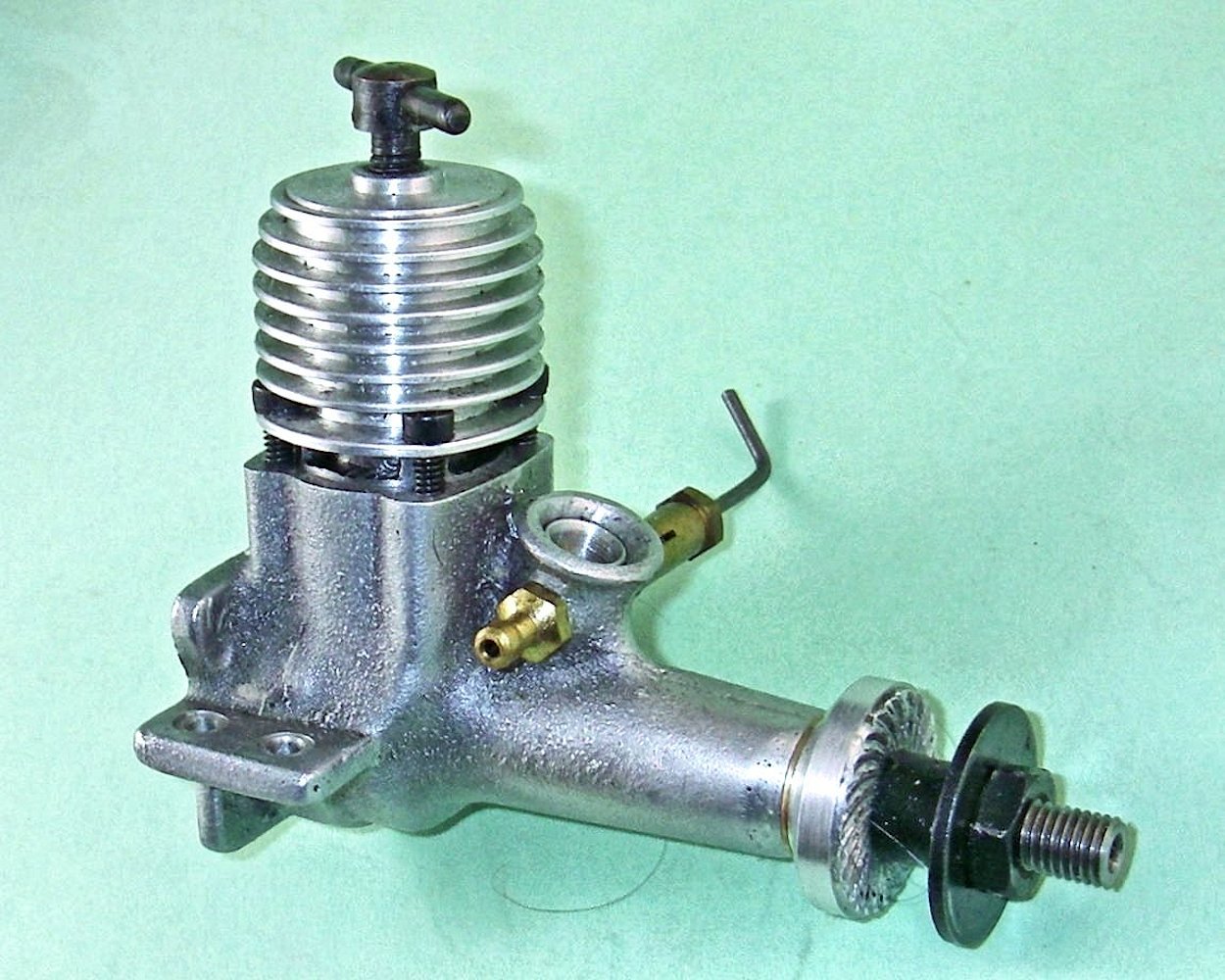 Until just a few months ago Bill was continuing to hold down the position of MECA President. He also remained willing at all times to respond to my inquiries about matters of model engine history, a subject which he knew as well as anyone. He was undoubtedly the world's leading expert on the history of the Fox marque. He will be sorely missed. Until just a few months ago Bill was continuing to hold down the position of MECA President. He also remained willing at all times to respond to my inquiries about matters of model engine history, a subject which he knew as well as anyone. He was undoubtedly the world's leading expert on the history of the Fox marque. He will be sorely missed. Another major loss to our community came with the passing of my fellow Canadian resident Dave Sugden on March 26th, 2020 in Oshawa, Ontario. A multi-talented individual who was both a qualified dentist and a full-sized aeronautical engineer, Dave is best remembered among members of the worldwide aeromodelling community for having designed the famous Sugden Special 2.5 cc diesel, many examples of which have been built by home constructors worldwide over the years. The example illustrated at the right was recently constructed by fellow Canadian Andrew Coholic.
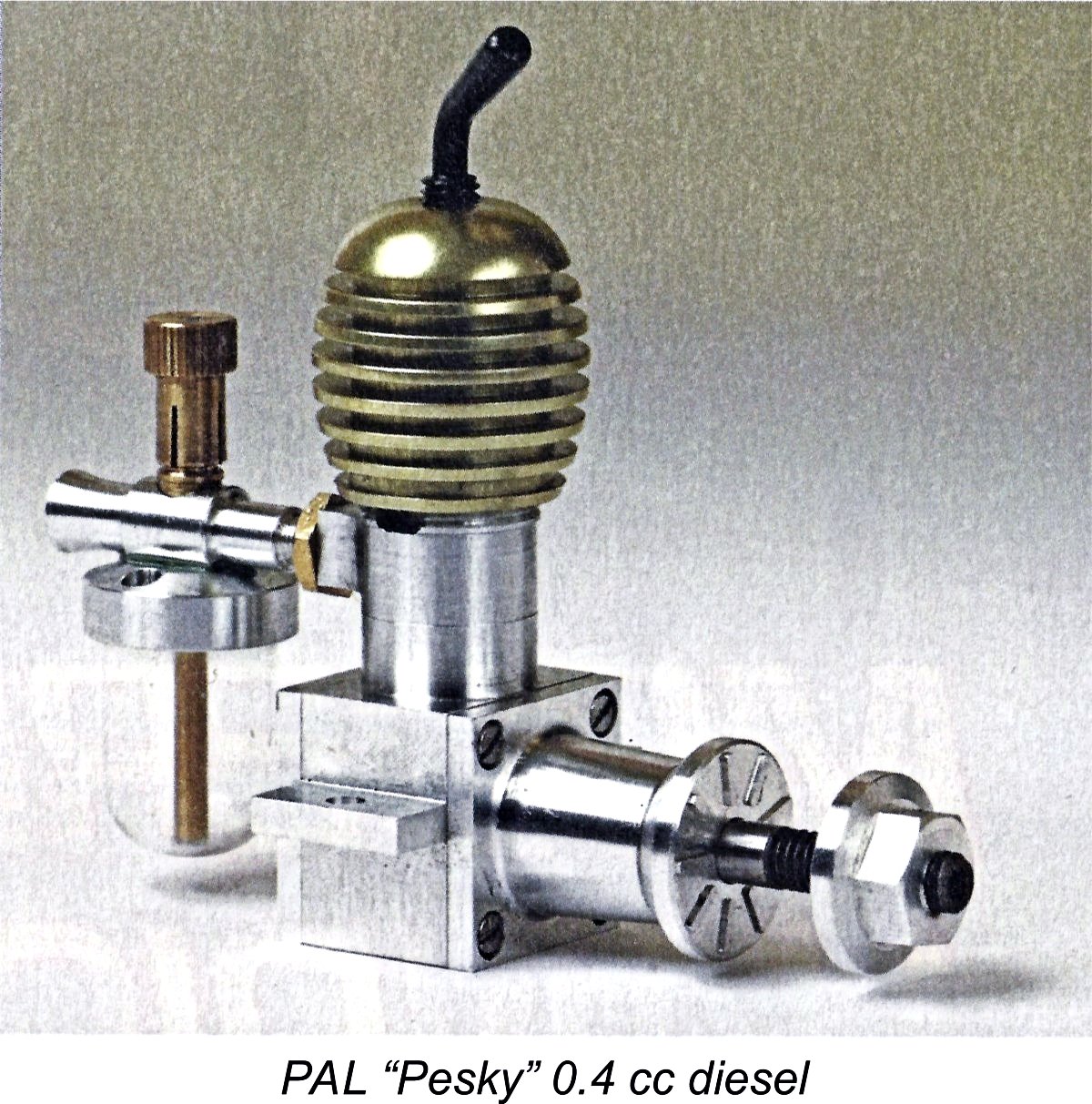 What is less well known is that after relocating from his native England to Canada in the mid 1950's (at which time he worked on the ill-fated Avro Arrow before returning to dentistry), Dave very capably represented his adopted country of Canada in numerous International free flight contests. He retained his passion for aeromodelling right up to the point at which he was sadly overtaken by the dementia which eventually claimed him. A full obituary of Dave Sugden may be found at this location. RIP, Dave, and many thanks. What is less well known is that after relocating from his native England to Canada in the mid 1950's (at which time he worked on the ill-fated Avro Arrow before returning to dentistry), Dave very capably represented his adopted country of Canada in numerous International free flight contests. He retained his passion for aeromodelling right up to the point at which he was sadly overtaken by the dementia which eventually claimed him. A full obituary of Dave Sugden may be found at this location. RIP, Dave, and many thanks. Two earlier departures which somehow escaped my previous notice include Bob Langelius of PAL Model Products and Al Kelly of Merlin glow plugs. PAL was the source of the 0.3 cc LOLA and 0.4 cc PESKY diesels, both of which are superb pieces of work. The PAL website remains active, but it's unclear to what extent the business is still functioning in Bob's absence.
Following Al Kelly's departure, the Merlin Glowplugs business is currently in limbo. Ian Thompson reportedly made what most agreed was a reasonable offer to take over the business, but the surviving family members evidently have a perception of the value of the enterprise which differs from the widely-held view. We'll just have to wait and see .................
 I've previously published an article by Maris Dislers on the subject of the Clanford Clan 0.24 cc diesel. As reported last month, I received my example of the Clan made by Dave Jones of Hervey Bay in Queensland, Australia. My example is engine no. 04 of the initial batch of 5 engines. It's a lovely piece of work. I have now given it a few test runs, finding it to be an excellent starter and a fine runner. However, it needs a little more running time before a full test is in order. Stay tuned ........... I've previously published an article by Maris Dislers on the subject of the Clanford Clan 0.24 cc diesel. As reported last month, I received my example of the Clan made by Dave Jones of Hervey Bay in Queensland, Australia. My example is engine no. 04 of the initial batch of 5 engines. It's a lovely piece of work. I have now given it a few test runs, finding it to be an excellent starter and a fine runner. However, it needs a little more running time before a full test is in order. Stay tuned ...........Speaking of Maris Dislers, he has been passing the time in self-isolation by re-reading some of the late Brian Winch's articles in "AIRBORNE" magazine. Like me, Maris didn't agree with some of Brian's comments (such as his recommendation to use an electric starter on diesels and his dismissal of castor oil as a lubricant), but he did sometimes come up with the goods. Noting Brian's suggestion regarding the use of a commonly-available bathroom cleaner (Ajax Professional Ultra Bathroom) for soaking steel parts afflicted with light surface rust, Maris decided than no harm could result from giving it a go. Combined with detergent for
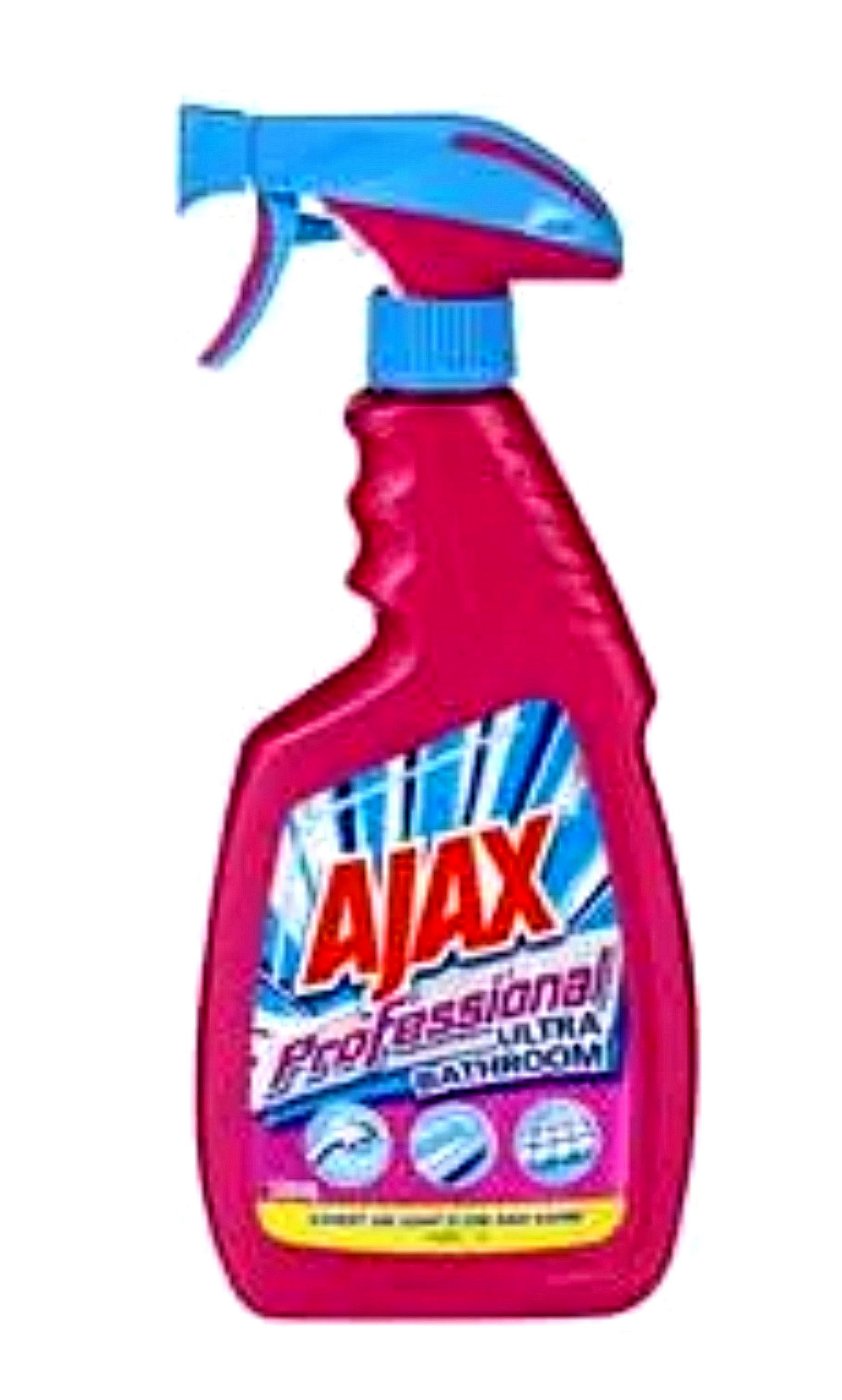 removing gunk, it did a pretty good job of cleaning a rusty glowplug spanner (wrench). Most likely the key ingredient is phosphoric acid, which is part of the standard industrial pre-treatment of steel surfaces. The surface was left a little grey from the phosphate coating, but was not etched. Worth a try - thanks, Maris! removing gunk, it did a pretty good job of cleaning a rusty glowplug spanner (wrench). Most likely the key ingredient is phosphoric acid, which is part of the standard industrial pre-treatment of steel surfaces. The surface was left a little grey from the phosphate coating, but was not etched. Worth a try - thanks, Maris! A few months ago I drew readers' attention to the current offering of engines from the collection of the late Paul Rossiter of England which may be found here on this website. It's gone very well - most of the listed engines have now sold, but a few remain available at what I consider to be very fair prices. It's a chance for my valued readers to get in there ahead of the eBay crowd and avoid the eBay fees. However, the current pandemic situation has created immense challenges in sending engines through the Postal service. Accordingly, for the present time sales have to be suspended. You can still contact me either directly or through the blog site to register an interest, but no money will change hands until normal service is resumed. Our apologies for the inconvenience.
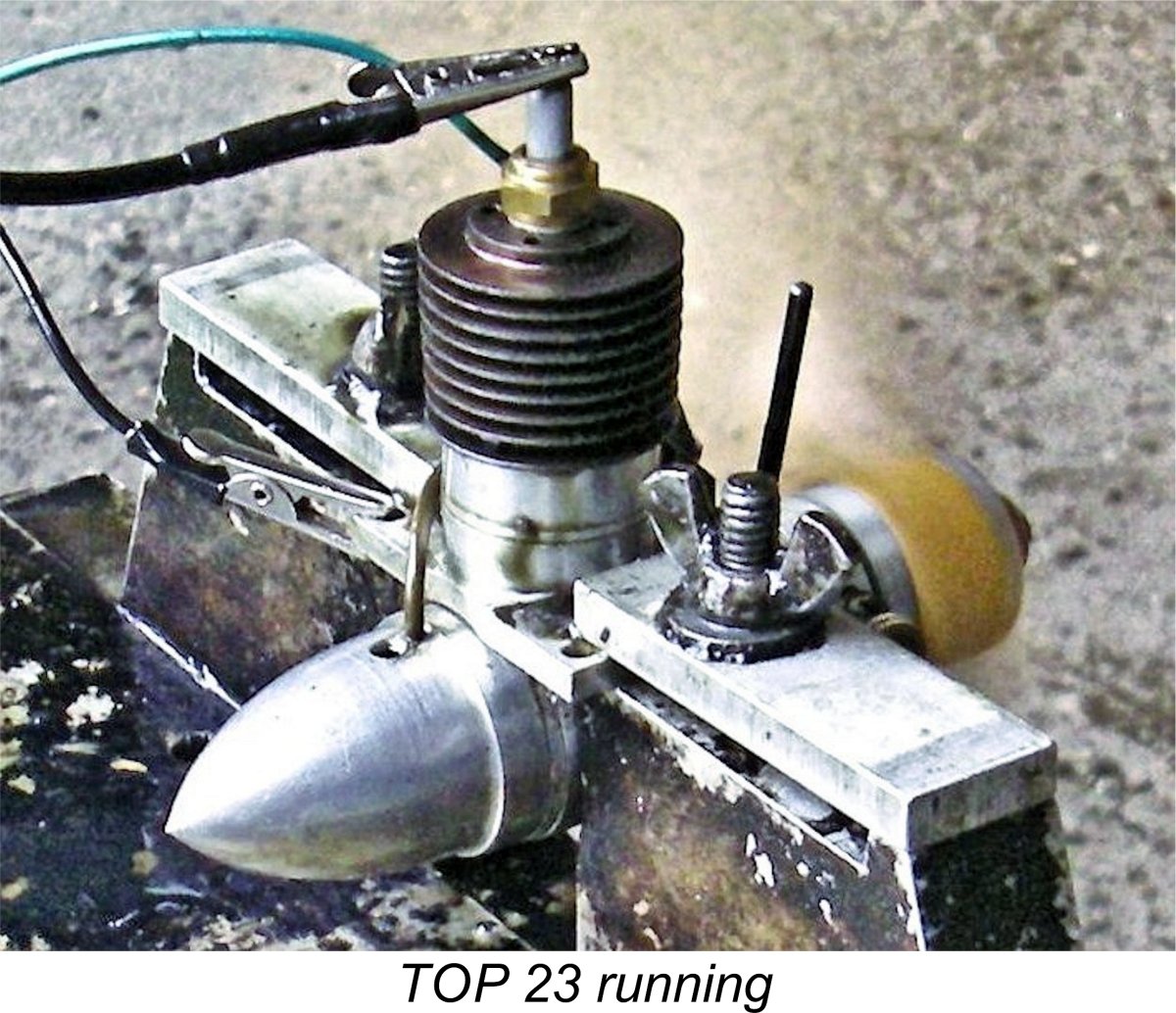 I previously mentioned having continued testing at some level despite the current pandemic situation - the neighbours simply have to put up with me! An interesting engine that I did get around to testing was a Japanese TOP 23 piston valve model from 1946/47. I've written about the TOP range in an article which may still be found on the late Ron Chernich's "Model Engine News" website, but did not undertake any testing in connection with that article. I previously mentioned having continued testing at some level despite the current pandemic situation - the neighbours simply have to put up with me! An interesting engine that I did get around to testing was a Japanese TOP 23 piston valve model from 1946/47. I've written about the TOP range in an article which may still be found on the late Ron Chernich's "Model Engine News" website, but did not undertake any testing in connection with that article. This was actually the first occasion on which I'd tested a piston valve design of any kind. The engine felt quite "different" when flipped over, but it fired up very easily indeed. Once running, I was very impressed with the results - the 73 year old TOP put on a most creditable performance! It invariably started promptly, ran extremely smoothly and achieved an output which was well in line with that of other contemporary models of similar displacement. All being well, I'll publish a full report in an upcoming issue. Meanwhile, a short video of the engine running may be viewed here.
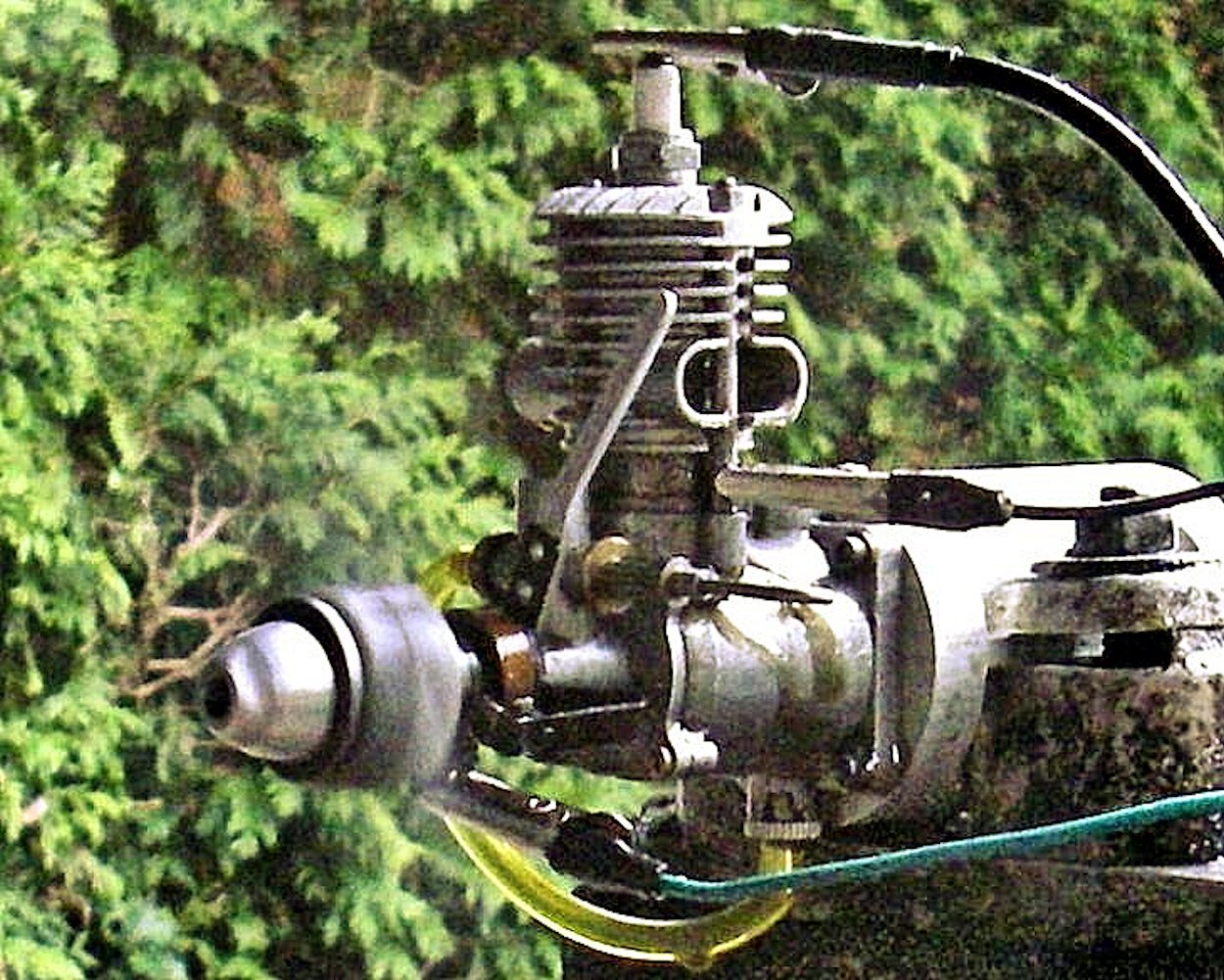 Just for fun, I also tested my late model FROG 175 sparkie. This one posed a bit of a challenge - the surface fuel jet with which it was fitted simply didn't generate enough suction to allow it to pick up and keep running. According to research carried out by Maris Dislers, this is a bit of a chronic problem with the "bicycle-spoke" FROG models. I ended up making a replica supply-side fitting on which the fuel jet was extended out to the middle of the intake venturi. Problem solved! Just for fun, I also tested my late model FROG 175 sparkie. This one posed a bit of a challenge - the surface fuel jet with which it was fitted simply didn't generate enough suction to allow it to pick up and keep running. According to research carried out by Maris Dislers, this is a bit of a chronic problem with the "bicycle-spoke" FROG models. I ended up making a replica supply-side fitting on which the fuel jet was extended out to the middle of the intake venturi. Problem solved!Once sorted, the engine ran very well indeed, albeit around 1000 rpm down on the FROG 180 diesel which Maris Dislers and I had tested earlier. Mind you, I was using the standard basic sparkie brew of 75/25 camp fuel and mineral oil - the use of glow fuel with a bit of nitro would doubtless have helped considerably. Still, I was pretty happy with the outcome of this test - those little FROG sparkers are really good runners!
Like my mate Maris, I too have been passing the time in isolation by reading old books, magazines and other publications. In doing so, I came across an item of relevance to last month's feature article on the Allen-Mercury (A-M) range. This was a comment which appeared in Ron Moulton's November 1960 "Aeromodeller" report on the 1960 World Control Line Championhips. The report cited the fact that the British FAI team-race partnership of Gordon Yeldham and Chas Taylor were using an engine called the "Steward Special" in their all-black team racer. This was specifically stated to be a prototype of a forthcomimng new A-M model, presumably having been developed by Len Steward.
In the event, nothing further was heard of this seemingly highly competitive design, using which Yeldham and Taylor finished in a very creditable third place against the best in the world. Indeed, I can find no further references to it. If anyone can throw some light upon this fascinating sideline to the history of the A-M enterprise, please get in touch! Meanwhile, I've rolled this reference into the A-M article.
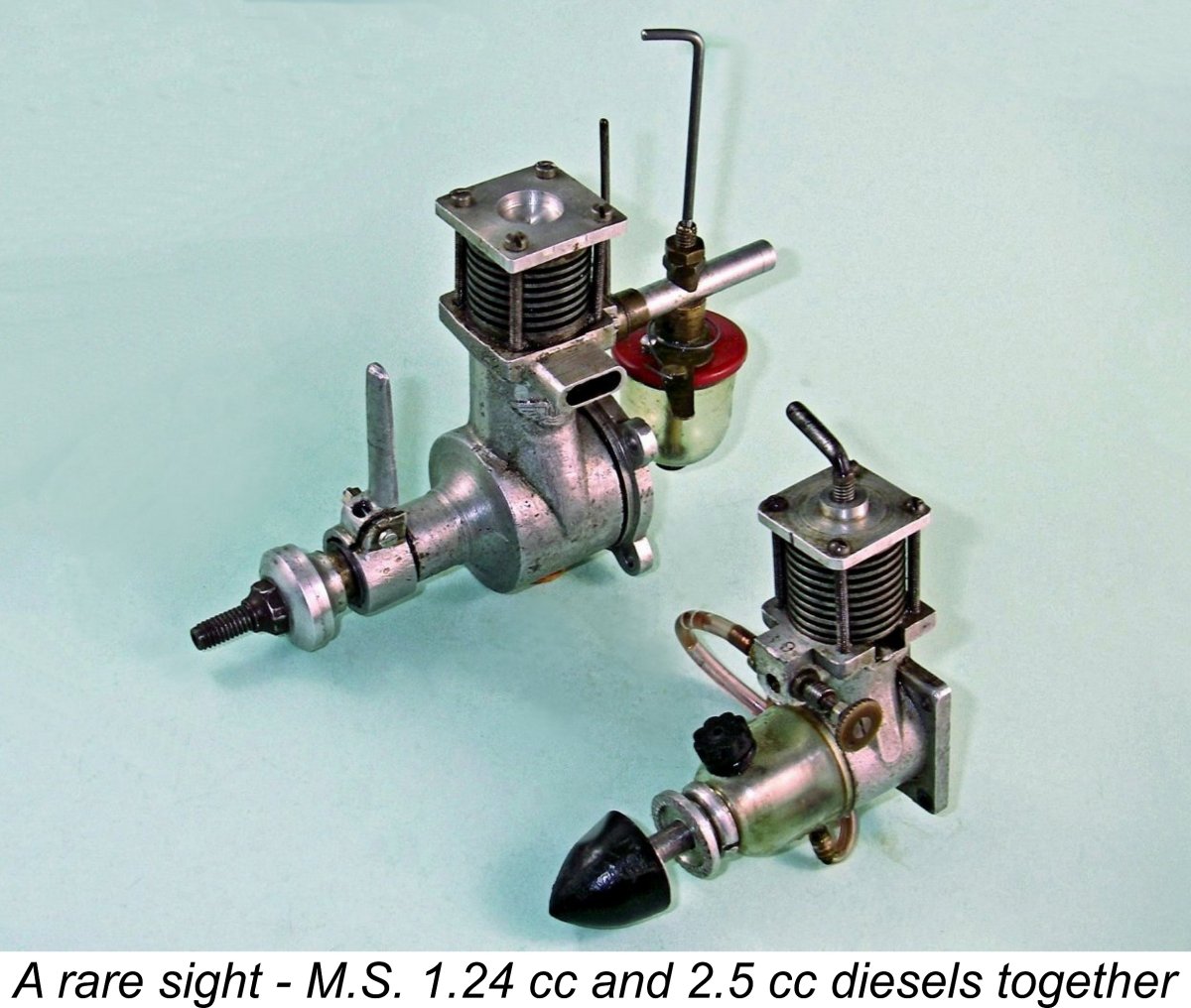 Turning now to this month's feature articles, I decided that this might be a time during which some of my fellow shut-ins might appreciate a bit of meaty reading on the topic of model engines! To address that potential need, I'm including not one but two lengthy articles in this issue. Turning now to this month's feature articles, I decided that this might be a time during which some of my fellow shut-ins might appreciate a bit of meaty reading on the topic of model engines! To address that potential need, I'm including not one but two lengthy articles in this issue. First off, I'm returning to form by indulging myself in another trip down Obscurity Alley! This time I'm publishing the first-ever in-depth review and bench test of the two successive M.S. diesels produced in extremely limited numbers by The Model Shop (Newcastle). This was almost certainly Britain's longest-surviving hobby shop, having been established in 1924 by Charles "Charlie" Lutman and remaining continuously in business until 2005 under the ownership of the Lutman family throughout.
After the end of WW2, Charlie Lutman established a factory on the Team Valley Trading Estate in nearby Gateshead, where he manufactured a wide range of modelling supplies and accessories. In mid 1947 he introduced the first of two successive model diesel engines, both of which exhibited a number of highly unusual features. The 2.5 cc model of mid 1947 (top left in the accompanying photo) was quickly followed in early 1948 by a 1.24 cc offering of somewhat different but still highly individualistic design. Neither model remained long in production, hence being extremely rare today.
The M.S. diesels were the subject of a very brief article on MEN by my good friend Ken Croft, who also made a fine replica of the 1.24 cc model. This month's feature article includes full bench tests of both models along with their complete design and production histories. I'm sure that you'll find it quite interesting to follow the design thinking behind these two very rare and interesting engines, both of which performed extremely well on the bench.
 By way of a bonus to give those of you who are sharing my current isolation some extra reading to relieve the hours of boredom, I'm including a second article this month. This is not an all-new article - rather, it is an update of an earlier article which appeared originally on the late Ron Chernich's MEN website. I've presented an updated review of the American-made ARGO Elfin 249 diesel which was marketed in the USA during the early to mid 1990's. By way of a bonus to give those of you who are sharing my current isolation some extra reading to relieve the hours of boredom, I'm including a second article this month. This is not an all-new article - rather, it is an update of an earlier article which appeared originally on the late Ron Chernich's MEN website. I've presented an updated review of the American-made ARGO Elfin 249 diesel which was marketed in the USA during the early to mid 1990's. This very well-made little engine achieved considerable popularity among SAM fliers in the USA and elsewhere. It is by no means an exact replica of the original 1949 Elfin 249 radial-mount model on which it was based, but it does maintain the general character of that unit while performing at a somewhat higher level. As a functional model powerplant with a "period" character, it is well able to stand on its own feet.
My original article on MEN was quite comprehensive when it was first published, but a considerable amount of additional information has since come to light. I've also carried out some more testing of the engine and its competitors. Because MEN is now frozen, it's not possible to make changes to articles posted there. Hence I have to transfer articles requiring updating to this site for attention. My ARGO review is such a case. I hope you enjoy the result!
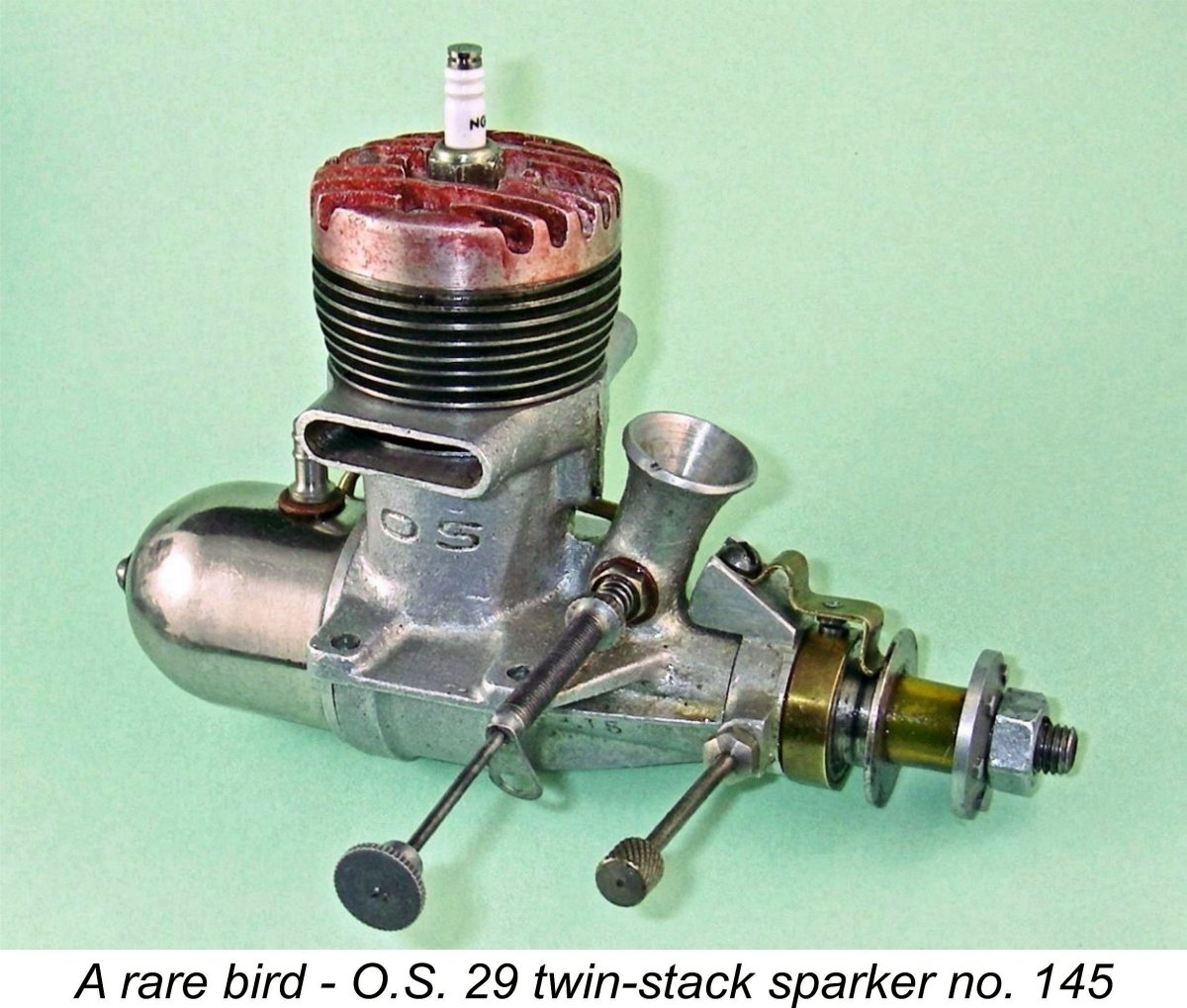 Looking ahead to next month, and assuming that I decide that it's worthwhile keeping going, I will re-visit early post WW2 Japan to take a really close look at one of the rarest engines to emerge from the O.S. factory - the sandcast twin-stack sparker of 1948. This engine too has been the subject of an earlier article on MEN, but that article did not include a full bench test. Next month's feature will address that deficiency in addition to adding a fair bit of updated information. As you'll learn, the engine proved to be an outstanding performer for a plain bearing spark ignition engine of its time and place! There's also an interesting American connection. Looking ahead to next month, and assuming that I decide that it's worthwhile keeping going, I will re-visit early post WW2 Japan to take a really close look at one of the rarest engines to emerge from the O.S. factory - the sandcast twin-stack sparker of 1948. This engine too has been the subject of an earlier article on MEN, but that article did not include a full bench test. Next month's feature will address that deficiency in addition to adding a fair bit of updated information. As you'll learn, the engine proved to be an outstanding performer for a plain bearing spark ignition engine of its time and place! There's also an interesting American connection. I think that's it for now. All being well, and if there seems to be enough interest despite the present situation, my present plan is to be back with another issue on or about May 1st, 2020. Meanwhile, please accept my very best wishes for making it safely through the present pandemic situation. The heady aroma of diesel fumes, sparkie smoke or burning nitro may be a bit more challenging to experience at this time, but I hope that at least some of you find an opportunity to get your fixes! Take care and stay well!!
Cheers, Adrian Duncan British Columbia, Canada ___________________________________ Note regarding material to be found on this site - unless specifically otherwise noted, all images and text which appear on this site are my own work, and I hereby assert my right to be recognized as the originator of this material. For the record, this material is made freely available to all upon two firm conditions:
Adrian C. Duncan British Columbia, Canada
|
| |
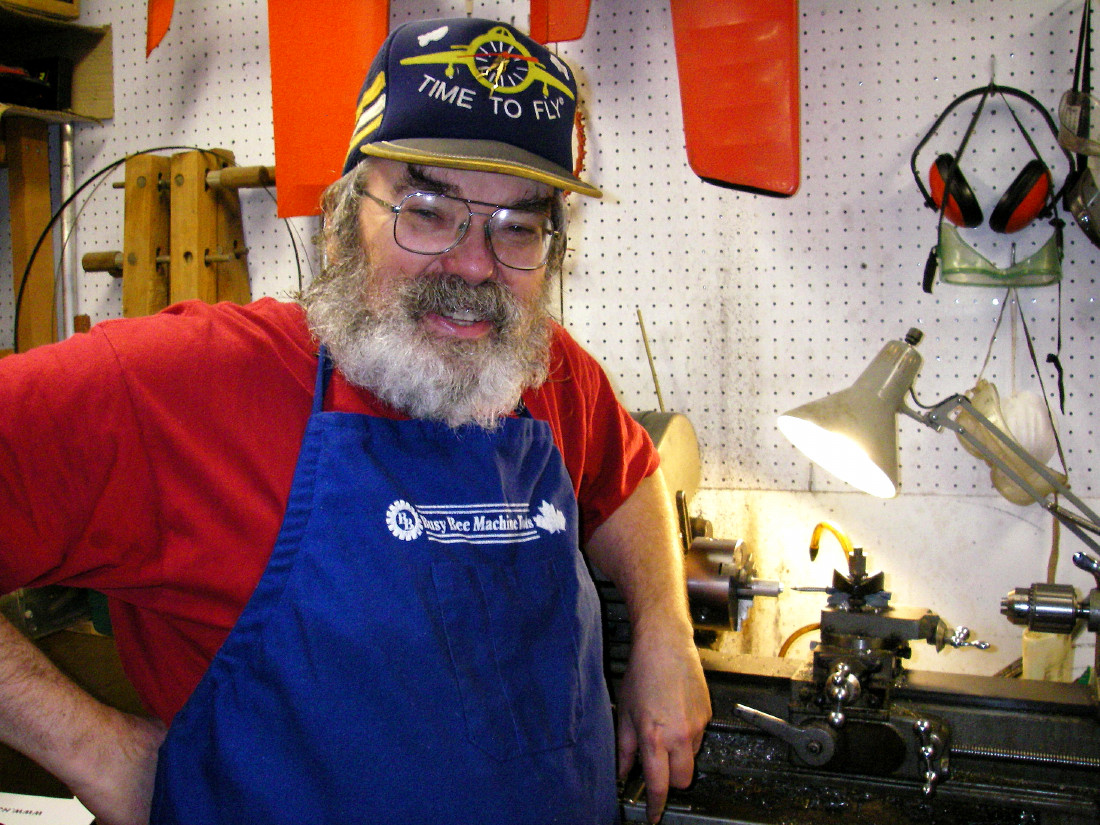 Well, here we are at April 1
Well, here we are at April 1